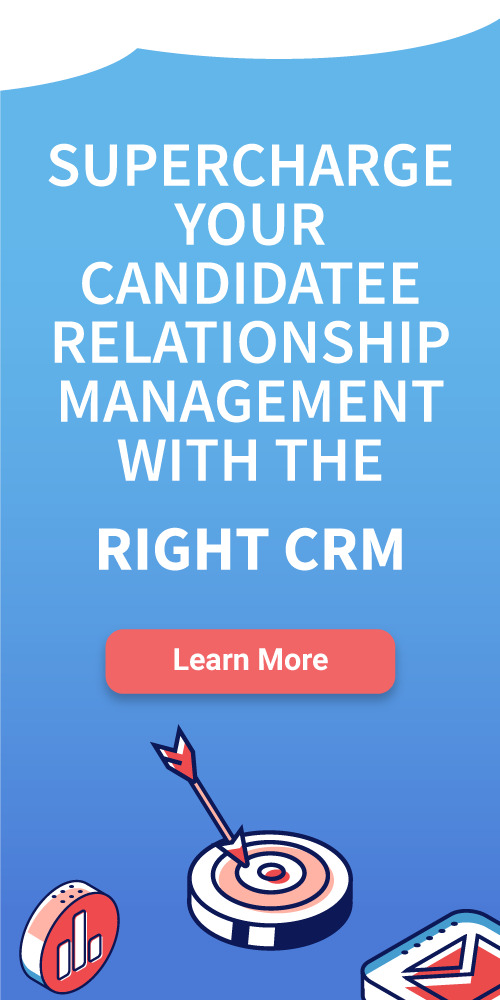Picture this: You’re swamped, juggling spreadsheets, your ATS is churning out duplicates, you keep losing candidates mid-process…and you’re one missed email away from losing a top-tier hire. Sounds familiar?
That chaos means one thing: it’s time to bring in a Recruiting CRM. Used right, a recruiting CRM software can streamline up to 80% of your hiring process in the pre-applicant state, making reliable pipelines more than a wish – they become a reality.
What’s the Difference Between an ATS and a CRM for Recruiters?

Recruiters often rely on two main tools to manage their hiring processes: an ATS (Applicant Tracking System) and a CRM (Candidate Relationship Management) system. While they might sound similar, these platforms serve very different—but equally important—purposes.
ATS: Your Hiring Tracker
An ATS is a system that helps manage candidates after they’ve applied. Think of it as your digital filing cabinet. It stores resumes, tracks application stages, and helps with compliance.
Key benefits of an ATS:
-
Speeds up the hiring process
-
Keeps all applications in one place
-
Tracks status for each candidate
-
Helps with reporting and legal compliance
CRM: Your Candidate Nurturer
A Recruiting CRM Software helps build relationships with candidates before they apply. It stores contact details, engagement history, and supports outreach via email or text. It’s like your personal talent pipeline builder.
Key benefits of a CRM:
-
Attracts passive candidates early
-
Keeps all communication in one place
-
Helps segment and organize talent pools
-
Personalizes outreach with templates and automation
Why You Need Both
Used together, an ATS and CRM cover the full recruitment lifecycle—from sourcing to hire. But if your ATS isn’t connected to a CRM, you might face these issues:
-
Your team spends more time on admin work than strategy
-
You can’t track which sourcing campaigns actually work
-
You end up entering the same candidate data into multiple systems
5 Signs It’s Time to Adopt Recruiting CRM Software

Duplicate Profiles Congesting Your ATS
The prevalent issue recruiting teams often encounter is that an ATS makes you work by requisitions. This accidentally lays specific restrictions on visibility. So, a candidate can apply for more than one job simultaneously, and your ATS will allow them to create duplicate profiles. A Recruiting CRM Software consolidates these into one golden profile—tracking every interaction, every milestone—so no update, achievement, or conversation goes missing.
No Central Hub for Candidate History
If your team is toggling between Excel sheets, ATS, email threads, and Slack notes…you’re wasting time and losing context. Recruiting CRMs automatically log every interaction, so you get complete candidate histories and smart searchability. That means no more platform-hopping—one place for full clarity.
Manual Email & Text Spamming
Recruiters manually typing hundreds of messages? That’s not recruiting—that’s busy work. Modern CRMs let you automate scheduled emails, texts, drip campaigns, and templates, saving you hours and keeping candidates informed—without the sweat. Messaging is more consistent, timely, and personalized.
You’re Not Top of Mind with Candidates
Passive candidates are gold—and they only respond if reminded. CRMs support email and SMS marketing, segmentation, and intelligent drip campaigns. Case in point: Balfour Beatty saw a 70% email open rate after implementing a CRM-driven strategy. Keeping your brand front and center pays off—bigly.
Monthly Reporting Is a Nightmare
Sourcing reports across fragmented systems? No thanks. A CRM centralizes data, giving you one-click access to source ROI, time‑to‑hire, pipeline health, and candidate engagement metrics. Generate accurate monthly reports in minutes—not days.
Conclusion
If you’re fighting siloed profiles, spending your life in spreadsheets or manual emails, can’t track candidate histories, don’t know how your sources perform, or feel invisible to top candidates—you don’t just need a CRM. You deserve one.
Adding a Recruiting CRM isn’t a cost. It’s an investment that pays back via time saved, better hires, happier candidates, and measurable ROI. Considering the wins we’ve covered, why wait?
💡 To optimize candidate experience, you can check out this article on candidate follow-up strategy to form better connections with your candidates.

Team Rakuna
The Rakuna Team comprises a diverse group of professionals hailing from various corners of the world.
With a passion to enable organizations to hire their next waves of talents, we are dedicated to help organizations stay updated on important recruiting technology and industry best practices.


